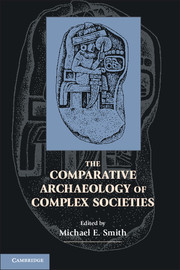Book contents
- Frontmatter
- Contents
- Tables
- Figures
- Contributors
- Foreword
- Preface
- Chapter 1 Comparative Archaeology
- Chapter 2 Approaches to Comparative Analysis in Archaeology
- Chapter 3 Comparative Frames for the Diachronic Analysis of Complex Societies
- Chapter 4 What It Takes to Get Complex
- Chapter 5 Challenges for Comparative Study of Early Complex Societies
- Chapter 6 Patterned Variation in Regional Trajectories of Community Growth
- Chapter 7 The Genesis of Monuments in Island Societies
- Chapter 8 Power and Legitimation
- Chapter 9 The Strategies of Provincials in Empires
- Chapter 10 Household Economies under the Aztec and Inka Empires
- Chapter 11 Low-Density, Agrarian-Based Urbanism
- Chapter 12 Archaeology, Early Complex Societies, and Comparative Social Science History
- Index
- References
Chapter 9 - The Strategies of Provincials in Empires
Published online by Cambridge University Press: 07 October 2011
- Frontmatter
- Contents
- Tables
- Figures
- Contributors
- Foreword
- Preface
- Chapter 1 Comparative Archaeology
- Chapter 2 Approaches to Comparative Analysis in Archaeology
- Chapter 3 Comparative Frames for the Diachronic Analysis of Complex Societies
- Chapter 4 What It Takes to Get Complex
- Chapter 5 Challenges for Comparative Study of Early Complex Societies
- Chapter 6 Patterned Variation in Regional Trajectories of Community Growth
- Chapter 7 The Genesis of Monuments in Island Societies
- Chapter 8 Power and Legitimation
- Chapter 9 The Strategies of Provincials in Empires
- Chapter 10 Household Economies under the Aztec and Inka Empires
- Chapter 11 Low-Density, Agrarian-Based Urbanism
- Chapter 12 Archaeology, Early Complex Societies, and Comparative Social Science History
- Index
- References
Summary
Empires, with their varied histories and characteristics, have been subjected to considerable scholarly scrutiny to detect recurrent imperial problems and their attempted solutions. Not so the provinces. Provincial people also face new challenges and opportunities in empires, but they have seldom been accorded the same degree of comparative study. This chapter is one way station in that effort.
In the intensive versus systematic spectrum of comparative approaches noted by Smith and Peregrine (Chapter 2), our effort began intensively for Stark in an attempt to understand archaeological data in an Aztec province (Skoglund et al. 2006). Four Aztec provincials’ strategies were identified that accounted for those data. Subsequently, our collaboration addressed Aztec provincials’ strategies more widely (data from other provinces) and, importantly, compared them with those in Colonial New Spain, Chance’s specialty. This widened perspective gave us two imperial cases, and we identified five additional strategies (Chance and Stark 2007). Clearly the expansion of the comparative base was crucial for understanding the range of provincials’ strategies.
- Type
- Chapter
- Information
- The Comparative Archaeology of Complex Societies , pp. 192 - 237Publisher: Cambridge University PressPrint publication year: 2011
References
- 3
- Cited by

